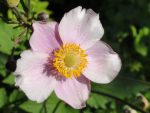
Native to Asia, this herbaceous perennial is a member of the buttercup family, Ranunculaceae, that also includes delphinium, clematis, and hellebore. It grows 3-4′ tall and forms a clump of gray-green leaves that have 5 deep lobes and resemble the leaves of grape plants. Loose clusters of 3-5 flowers appear on branched stems 1.5-2′ above the foliage from late summer into fall. The 2-3″ wide flowers lack petals but have 5-8 white to pale pink showy sepals surrounding a yellow center. White woolly fruits persist into winter. Plants are attractive in borders especially in shady areas. The genus name, Anemone, is probably a corrupted Greek loan word of Semitic origin referring to the lament for the slain Adonis or Naaman, whose scattered blood produced the blood-red Anemone coronaria. The specific epithet, vitifolia. comes from the Latin words vitis meaning grapevine, and folium, meaning leaf and refers to the resemblance of the leaf to that of the grape plant.
Type: Herbaceous perennial
Bloom: White to pink flowers 2-3′ wide from late summer into fall
Size: 3-4′ H x 2′ W
Light: Partial shade
Soil: Average, consistently moist, well-drained
Hardiness: Zones 5-8
Care: Low maintenance
Pests and Diseases: None of significance
Propagation: Division, root cuttings, seed
Companion Plants: Toad lily, monkshood, cohosh
Photo Credit: Wikipedia